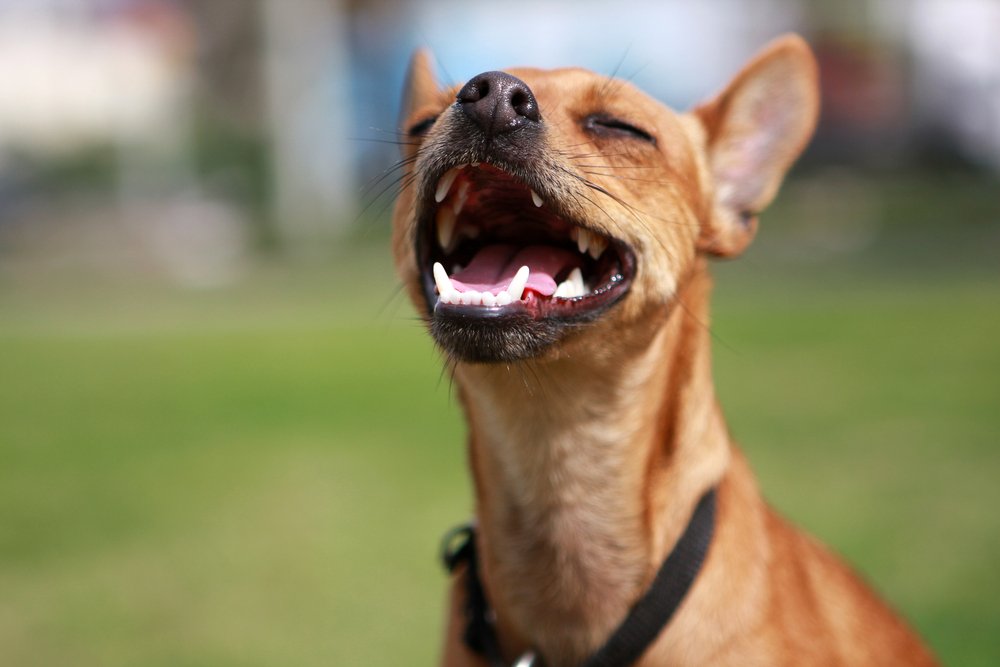It often seems like our dogs are just some kind of little person and there’s a reason so many of the younger generations are turning to pups and not kids! Still there are, of course, limits to how similar our dogs really are to us.
And while we know that dogs can’t really talk back to us (although huskies definitely try) it does seem like our dogs can smile and maybe even laugh. But is that really true?
Dogs can smile but it’s not always a sign of happiness and in many cases, it’s actually a sign of submission. However, there’s some debate around whether or not dogs can laugh but some researchers have identified what they think is a canine laugh.
Let’s take a closer look!
Can Dogs Smile?
The classic canine smile doesn’t happen because our dogs found something funny but instead usually indicates a relaxed dog.
But because a relaxed, open mouth looks close enough to a smile, humans are quick to interpret it as such.
And we’re not completely wrong.
In the majority of cases, the canine smile does suggest a happy, content, and relaxed dog.
But like the human smile, a dog’s smile doesn’t always mean one thing.
Just as many humans have a nervous smile, a stressed or anxious dog can also take on a smile as they nervously pant.
That’s why it’s so important to have a big picture perspective on a dog’s body language and understand all the context clues. Dogs with a wagging tail, relaxed, partially closed eyes, and a big smile on their face might as well be smiling because they’re happy.
While dogs that have tense, tight body postures and are constantly looking around the room probably aren’t smiling because they’re happy- even if their tongue is hanging out.
Then there’s an entirely different kind of smile called the submissive smile!
Like a human smile, dogs showing a submissive smile or grin will show their teeth but instead of expressing joy, these dogs are letting the world know that they’re not a threat.
Again, context is important here and while a submissive grin can look very similar to a dog baring teeth there’s a big difference in body language.
Dogs showing off their submissive smile or grin will often squint their eyes, wag their tail, lick their loops and periodically shift their head and gaze up and down or side to side. Overall, they take on submissive or deferential postures to match their smile.
A dog baring teeth on the other hand will have wide eyes and usually a direct stare along with stiff postures.
So while dogs certainly look like they’re smiling, whether that’s with a relaxed face and their tongue hanging out or with a submissive grin, it’s important to look at the overall body language for any dog to really understand what’s going on.
Can Dogs Laugh?
There’s quite a bit of debate about whether or not dogs laugh- at least in the same way that we do.
We do know that dogs engage in a vocalization called a ‘play-pant’. As you’d expect from the name, this vocalization primarily occurs during play and dogs will let out quick pant or huff as a way to encourage other dogs or people to play.
Sometimes referred to as a dog’s laugh, the play-pant is almost always accompanied by behaviors like play bowing, loose body postures, and a wagging tail. Which makes it one of several ways that dogs ask to play.
The play-pant is a lot more subtle than many human laughs and it’s very easy to miss considering it’s usually accompanied by a happy, bouncy, and wiggling dog.
Even more interesting, researchers played recordings of the play-pant to puppies and shelter dogs. They found that many puppies started play bowing in response to the sound and dogs in the shelter were found to be less stressed after hearing the play-pant.
So while dogs may not laugh at a funny joke like humans, they do seem to have a vocalization that’s used to promote friendly social interaction.
How Can You Tell If A Dog Is Happy?
When it comes to body language, happy dogs have loose, relaxed postures from nose to tail. That includes a loose mouth, soft eyes, and relaxed ears.
Outside of body language, happy dogs are usually less destructive and generally eager to engage with the world around them.

